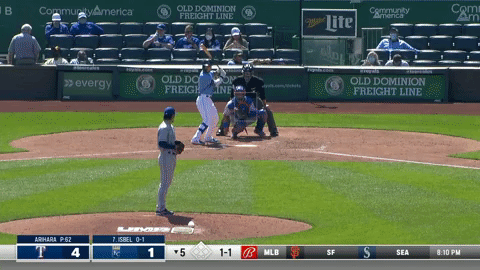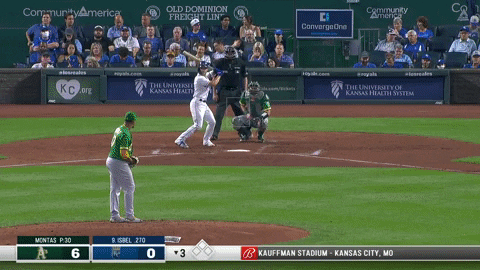Taking Something from Kyle Isbel's Small Sample
The young outfielder spent much of the season in AAA, but the changes were obvious when he came back to the big leagues.
As the Royals were entering their final couple weeks of spring, all the talk centered around Bobby Witt Jr. and if he’d make the roster. But while that was going on, another prospect, not nearly as hyped, was making a big push to be a part of the Opening Day team. It wasn’t until toward the last week that people began to take notice of how Kyle Isbel was playing and there was a particular televised game in that last week when he hit some absolute rockets. That was the game that I believe cemented his place on the roster to start the 2021 season. While he had three hits on Opening Day, things weren’t great from there and he eventually was sent down, first to the alternate site and then to Omaha.
And things weren’t great for him in Omaha at first either. After a couple weeks at the alternate site waiting on the season to start, Isbel finally got to play in games again. And he got some hits, but with very little authority. He was 10 for his first 26 but only had two doubles. Plus he struck out seven times in his first 28 plate appearances and walked just once. He wasn’t playing his game. So he started making adjustments and slowly started coming out of it. I’ve got an arbitrary endpoint alert, but he hit .229/.340/.396 over his next 282 plate appearances after those first 28. The strikeout rate was getting back to where it needs to be for him and he was walking more, but the results didn’t come.
He had two hits the next day. Then three the day after that. But he still wasn’t driving the ball. I’m not exactly sure when the adjustment was made, but he got more comfortable with whatever it was he was doing and the power would follow soon. From the start of a series at home with the Columbus Clippers to the day he was promoted, Isbel hit .314/.368/.581 with six homers, three doubles and a triple in 95 plate appearances. The Royals had a need with Michael A. Taylor going on the family emergency list, so up he came.
And from that point forward, Isbel looked the part. He wasn’t hitting moonshots or anything, but he had seven extra base hits, including his first big league home run, and had a .286/.362/.524 line in 47 plate appearances. Striking out eight times and walking five in that time was a big plus for him as well. I thought he even held his own in center field when playing there. The metrics don’t agree, but defensive numbers are far too finicky in a 64 inning sample to put much stock into them. I’m not worried about his defense today. I want to look at the differences offensively.
Let’s start with some video. I went to Baseball Savant and found two random pitches where Isbel made contact at Kauffman Stadium so we’d even get a pretty much identical camera angle. The first was from April and the second from September. Take a look.
April:
September:
The differences are obvious. You can see it in the setup from the start. I don’t know how you could miss it, but in case you did, here are the screenshots.
April:
September:
He just gets started with a much more open stance and that seemed to help him keep the bat in the zone long enough to be able to do some damage. What’s interesting is that the swing itself isn’t that much different. Once he gets the bat head to the zone, he looks almost identical to what he was doing in April, but like I said, the wider stance seems to allow him to drag his bat through the zone a bit more and maybe get into a hitting position a touch earlier so he’s not topping that ball like he did back in April.
Isbel talked about this a bit with Alec Lewis of The Athletic in an article he wrote that makes this one seem a little redundant after I googled it looking for this quote that I had remembered. He was talking about being more aggressive and getting into a better hitting position because the toughest pitchers in the league were eating him up during his first short stint.
As Lewis wrote, Isbel worked with the Royals hitting crew in the minors that had worked wonders for so many and they wanted to fix his “hip slide” as he calls it.
The result was a suggestion: Turn your back foot inward to eliminate pressure that the inside part of his foot had been applying.
“That really cleaned up my path a lot,” Isbel said. “I don’t know (how they figured it out). That’s why they have that job. They help me in so many different ways. They’re amazing. Seriously. I’m so thankful.”
It’s pretty clear in the above video and shots what he did differently. My thought was always that I like his actual swing a lot, but I never especially thought about how his setup might provide him some difficulty to get to it. It definitely makes sense that a new setup could play up his swing much more.
Let’s take a look at the results:
In his first stint, Isbel hit .265/.306/.324. Remember, we’re working with a very small sample, so it’s hard to say for certain if that was an earned bad line or if some time would have turned that around. Except that it was completely earned. In fact, it might have been overachieving with a BABIP of .474. He walked 5.6 percent of the time, struck out 41.7 percent of the time and had just one fluke triple that was actually a pretty lazy fly ball that was lost in the sun.
To make matters worse, he was swinging at 41.8 percent of pitches outside the zone and only 54 percent of pitches in the zone. That 41.8 percent was about 17 percent above the league average for the season and the 54 percent as about 15 percent below the league average for the season. So what he mentioned in The Athletic article rings true. He was waiting on a perfect pitch from a pitcher who will never give a perfect pitch and ended up having to swing at their pitch.
It’s hard to think back to the moment this far away from it, but watching his plate appearances seemed to get harder and harder.
Now fast forward to his return. We know the batting line, but he walked 10.6 percent of the time and struck out just 17 percent of the time. Now that’s more like it. The BABIP was reasonable for a guy with his speed at .333. He still swung at too many pitches out of the zone with 37.9 percent rate there, but he also swung at strikes. He was still a touch below the league average at 66.7 percent, but he was giving himself a chance.
Those are obvious changes. But something he was doing to give him more of an opportunity to do damage was to actually lift the ball. Before getting sent down, he had an average launch angle of just 3°. His fly ball percentage was just 33.3 percent. He wasn’t hitting a ton of ground balls necessarily, but he wasn’t giving himself a chance to drive the ball. After returning, the launch angle was 26°, which is a little higher than you want, but better, and the fly ball rate was up to 54.5 percent. With the change in physical approach, it allowed him to drive the ball a little more.
Now, all that said, the expected stats don’t buy the improvement. His expected slash line of .216/.299/.307 is actually worse than his expected slash line before his demotion of .229/.321/.316. So where does the truth lie if we’re going to be making a big conclusion?
For my eyes, I saw a better hitter. He was more patient when patience was appropriate and aggressive when aggression was appropriate. He seemed to have a better plan at the plate and was able to do more damage when he swung the bat. It’s probably worth noting that with a sample that size, there could be some big jumps in the expected stats, so we probably shouldn’t put too much stock into them, but this whole thing is an exercise in small sample.
What I like from Isbel is that he acknowledged a problem and allowed a coaching and support staff that has a great track record to work with him. He has obvious talent and when you combine talent with a willingness to change when change is necessary, that’s a positive attribute for sure. So no, you can’t make any huge proclamations about a player in just 83 plate appearances, but I’m a sucker for a guy who gets knocked down, adjusts and finds success.
Is it likely that Isbel is a future middle-of-the-order hitter as the September stats might suggest? I would say no, but he doesn’t need to be. The Royals future offensively will be defined by how guys like Witt, MJ Melendez and Nick Pratto do. And if someone else steps up to be their peers offensively, great, but that still lives six spots in the order to fill with hitters who can fill their own role. Isbel showed me that he at least has a chance to be that guy. I want to see more, but I was very impressed with the turnaround and, from my eyes, he looks like a guy you can count on somewhere outside of the 3-6 spots in the batting order to help deepen a lineup.






I'm still an Isbel skeptic. I agree, he doesn't need to be the best hitter on the team. But he'll have to make up for that with value in other places (like defense) otherwise he's just a guy. Royals need contributors more than they need cost savings of a JAG at this point in time.
To me, the best part of this story is the insight into the improved hitting coaching. That's some really impressive work.
I really like Isbel. I believe Isbell = Beni ntendi.